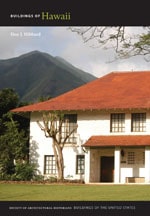
After Honolulu and Hilo, the Lihue post office was the third of four post offices constructed by the federal government in the Territory of Hawaii prior to World War II. This simple, single-story, reinforced-concrete, Spanish Mission Revival building resulted from the adaptation of a standard federal design to meet the climatic conditions of Hawaii. Originally planned by federal architects along classical lines with a flat roof and storm doors, the proposed building was promptly labeled a “cracker box” by the local power brokers. In response to the demands of these Lihue citizens, the design was modified to comport more closely with post offices constructed in Southern California, thanks to the efforts of postal engineer Floyd Williams, who had previous experience with construction in the Virgin Islands and Puerto Rico. In turn, the Lihue post office appears to have served as a prototype for the post office (1940) at Schofield Barracks on Oahu.
The building presents a symmetrical facade to Rice Street. A red tile shed roof overhangs the three central bays, flowing downward from, and balancing, the vertical thrust of the gable end. Situated beyond the central bays is the lobby with its postboxes and service counters. The L-shaped lobby wraps around the right side, which because of a parking lot now serves as the primary entrance. Originally the lobby was open, but later was glassed in to keep out the rain and wind. Two wood sculptures in low relief carved by Marguerite Blasingame of Honolulu grace the lobby's walls. One depicts upraised hands holding an adze and the other a man about to sound a conch shell.
Louis A. Simon (1867–1958) served as the chief of the architectural division in the U.S. Treasury Department's Office of the Supervising Architect from 1915 until 1933; from 1933 to 1941 he was the supervising architect.

